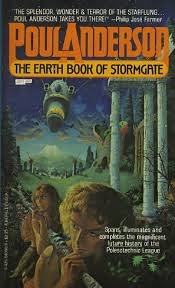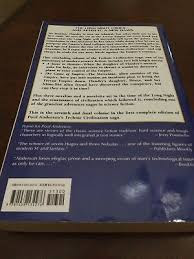One
of the things I most admire about Dr. Paul Shackley's work in the Poul
Anderson Appreciation blog is the detailed attention he pays to the
texts of the works of Poul Anderson. Far more attention than what I
have usually done since the last time I was writing letters to Anderson
himself (and before my participation on this blog).
Currently,
I have been slowly rereading the stories about Dominic Flandry, set
during the era of the Terran Empire in Anderson's Technic Civilization
series. And while doing so I have been striving to pay attention to,
and appreciate, even the smallest details to be found in those stories.
One example, from the Gregg Press (August, 1979) edition of AGENT OF THE
TERRAN EMPIRE, is from the beginning of Chapter II of HUNTERS OF THE
SKY CAVE (also called WE CLAIM THESE STARS), in an artificial satellite
orbiting Jupiter called the Crystal Moon: "He wasted no time on excuses
but almost ran to the cloakroom. His feet whispered along the
crystalline floor, where Orion glittered hundreds of light years
beneath." In all my previous readings of HUNTERS I don't think I had
ever really NOTICED that bit about Flandry racing along a crystalline
floor, beneath which Orion could be seen hundreds of light years away!
But
the textual detail I wish to pay special attention to is a truly
obscure one: how many heads do Ymirites have? The only time we see any
members of this hydrogen breathing non human intelligent race is in
HUNTERS OF THE SKY CAVE. And while I was reading Chapter IV of that
story I noticed a tiny but intriguing detail (quoting from page 115 of
the Gregg Press edition): "Flandry looked into the screen. The Ymirite
didn't quite register on his mind. His eyes weren't trained to those
shapes and proportions, seen by that weirdly shifting red-blue-brassy
light. (Which wasn't the real thing, even, but an electronic
translation. A human looking straight into the thick Jovian air would
see only darkness.) "Hello, Horx," he said to the great black multi-
legged shape with the peculiarly tendrilled heads."
It
was that last bit, "...the peculiarly tendrilled heads," which caught
my eye. How literally are we supposed to understand that word "heads"?
Do Ymirites have at least two heads? We see Flandry conversing with two
Ymirites in HUNTERS, his guide/interpreter Horx and the Ymirite
governor of Jupiter, Thua. But no mention is made of those beings
having multiple personalities if they have more than one head, which is
what we see in human conjoined twins. Rather, if Ymirites have more
than one head, only one personality is seen as using and speaking with
those heads.
I
was surprised! In all my previous readings of HUNTERS OF THE SKY CAVE,
I had never noticed that bit about Horx having
"...peculiarly tendrilled heads." I wondered if that might have been
just a misprint for "head" and decided to see what the other copies I
have of that story said at exactly the same place in those texts.
From
Chapter IV of WE CLAIM THESE STARS (Ace Books: 1959), page 26 : "Hello,
Horx," he said to the great black multi-legged shape with the
peculiarly tendrilled heads."
AGENT
OF THE TERRAN EMPIRE (Chilton Books: 1965), from Chapter IV of HUNTERS
OF THE SKY CAVE, page 100: "Hello, Horx," he said to the great black
multi-legged shape with the peculiarly tendrilled heads."
WE
CLAIM THESE STARS (London, Dobson Books: 1976 [rpt. of the 1959 Ace
Books text]), from Chapter IV, page 26: "Hello, Horx," he said to the
great black multi-legged shape with the peculiarly tendrilled heads."
ALL
the copies I have of HUNTERS OF THE SKY CAVE have "heads" at precisely
this same part of the text. Based on this evidence, I have to conclude
"heads" was not a misprint for "head." I feel forced to at least
tentatively say Ymirites have more than one head. Even though that
single sentence I have been quoting is the only time where Ymirite heads
are mentioned. And Ymirites are not described as being any kind of
conjoined twins, two different persons sharing the same body or parts of
bodies.
Despite
everything, was this use of "heads" still a mistake? Did Poul Anderson
actually intend "head"? If he meant the former, he certainly left us a
mystery! All the other few mentions of Ymirites in the Technic stories
(such as in ENSIGN FLANDRY or THE GAME OF EMPIRE), says nothing about
their bodies and appearances. E.g., this is what we see near the
beginning of Chapter 9 of ENSIGN FLANDRY, about the Ymirites, as Lord
Hauksberg's ship was traveling from Starkad to Merseia: "Once, also,
another vessel passed within a light-year and thus its "wake" was
detected. The pattern indicated it was Ymirite, crewed by hydrogen
breathers whose civilization was nearly irrelevant to man or Merseian."
I
have to admit that these questions would only be of interest to
Andersonian obsessives! If I had noticed this detail and thought of
writing to Anderson about it while he was alive, I think he would most
likely have replied it was "head" he meant at that part of WE CLAIM
THESE STARS/HUNTERS OF THE SKY CAVE. Another way of settling this
question, after Anderson died, would be to check what the original
manuscript of HUNTERS had at this part of the text. Assuming that
manuscript still exists, of course.
I
think some commentators who discuss science fiction stories have
complained that too many writers make their non-human aliens look too
much like human beings. A hydrogen breathing, multi-legged intelligent
species with "peculiarly tendrilled heads" could not be considered as
humanoid by any reasonable interpretation of that word. Poul Anderson's
Ymirites cannot be accused of being too humanoid looking.











































